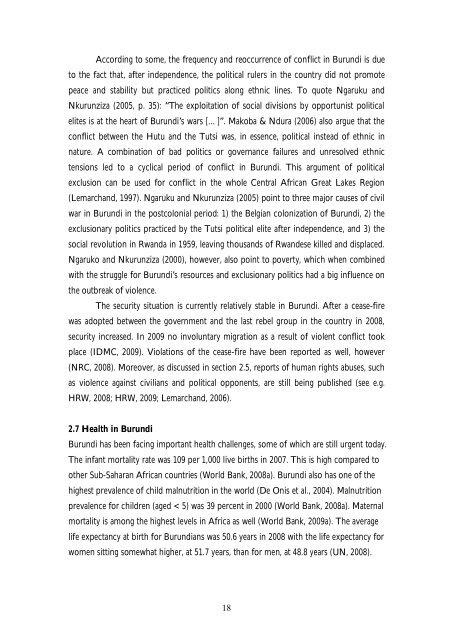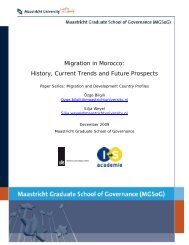Migration in Burundi: History, Current Trends and Future - MGSoG ...
Migration in Burundi: History, Current Trends and Future - MGSoG ...
Migration in Burundi: History, Current Trends and Future - MGSoG ...
You also want an ePaper? Increase the reach of your titles
YUMPU automatically turns print PDFs into web optimized ePapers that Google loves.
Accord<strong>in</strong>g to some, the frequency <strong>and</strong> reoccurrence of conflict <strong>in</strong> <strong>Burundi</strong> is due<br />
to the fact that, after <strong>in</strong>dependence, the political rulers <strong>in</strong> the country did not promote<br />
peace <strong>and</strong> stability but practiced politics along ethnic l<strong>in</strong>es. To quote Ngaruku <strong>and</strong><br />
Nkurunziza (2005, p. 35): “The exploitation of social divisions by opportunist political<br />
elites is at the heart of <strong>Burundi</strong>’s wars [… ]”. Makoba & Ndura (2006) also argue that the<br />
conflict between the Hutu <strong>and</strong> the Tutsi was, <strong>in</strong> essence, political <strong>in</strong>stead of ethnic <strong>in</strong><br />
nature. A comb<strong>in</strong>ation of bad politics or governance failures <strong>and</strong> unresolved ethnic<br />
tensions led to a cyclical period of conflict <strong>in</strong> <strong>Burundi</strong>. This argument of political<br />
exclusion can be used for conflict <strong>in</strong> the whole Central African Great Lakes Region<br />
(Lemarch<strong>and</strong>, 1997). Ngaruku <strong>and</strong> Nkurunziza (2005) po<strong>in</strong>t to three major causes of civil<br />
war <strong>in</strong> <strong>Burundi</strong> <strong>in</strong> the postcolonial period: 1) the Belgian colonization of <strong>Burundi</strong>, 2) the<br />
exclusionary politics practiced by the Tutsi political elite after <strong>in</strong>dependence, <strong>and</strong> 3) the<br />
social revolution <strong>in</strong> Rw<strong>and</strong>a <strong>in</strong> 1959, leav<strong>in</strong>g thous<strong>and</strong>s of Rw<strong>and</strong>ese killed <strong>and</strong> displaced.<br />
Ngaruko <strong>and</strong> Nkurunziza (2000), however, also po<strong>in</strong>t to poverty, which when comb<strong>in</strong>ed<br />
with the struggle for <strong>Burundi</strong>’s resources <strong>and</strong> exclusionary politics had a big <strong>in</strong>fluence on<br />
the outbreak of violence.<br />
The security situation is currently relatively stable <strong>in</strong> <strong>Burundi</strong>. After a cease-fire<br />
was adopted between the government <strong>and</strong> the last rebel group <strong>in</strong> the country <strong>in</strong> 2008,<br />
security <strong>in</strong>creased. In 2009 no <strong>in</strong>voluntary migration as a result of violent conflict took<br />
place (IDMC, 2009). Violations of the cease-fire have been reported as well, however<br />
(NRC, 2008). Moreover, as discussed <strong>in</strong> section 2.5, reports of human rights abuses, such<br />
as violence aga<strong>in</strong>st civilians <strong>and</strong> political opponents, are still be<strong>in</strong>g published (see e.g.<br />
HRW, 2008; HRW, 2009; Lemarch<strong>and</strong>, 2006).<br />
2.7 Health <strong>in</strong> <strong>Burundi</strong><br />
<strong>Burundi</strong> has been fac<strong>in</strong>g important health challenges, some of which are still urgent today.<br />
The <strong>in</strong>fant mortality rate was 109 per 1,000 live births <strong>in</strong> 2007. This is high compared to<br />
other Sub-Saharan African countries (World Bank, 2008a). <strong>Burundi</strong> also has one of the<br />
highest prevalence of child malnutrition <strong>in</strong> the world (De Onis et al., 2004). Malnutrition<br />
prevalence for children (aged < 5) was 39 percent <strong>in</strong> 2000 (World Bank, 2008a). Maternal<br />
mortality is among the highest levels <strong>in</strong> Africa as well (World Bank, 2009a). The average<br />
life expectancy at birth for <strong>Burundi</strong>ans was 50.6 years <strong>in</strong> 2008 with the life expectancy for<br />
women sitt<strong>in</strong>g somewhat higher, at 51.7 years, than for men, at 48.8 years (UN, 2008).<br />
18



